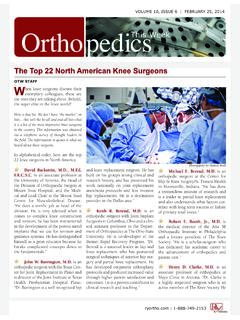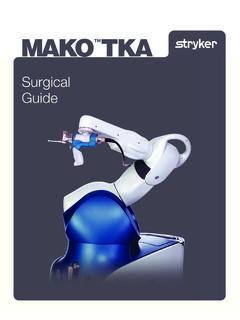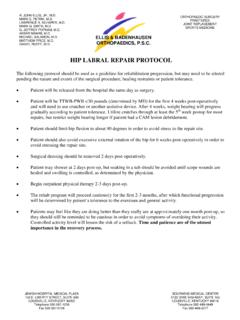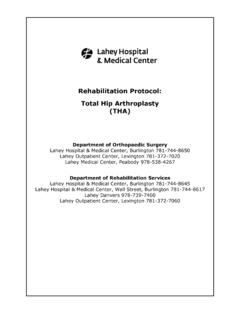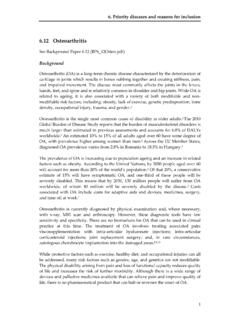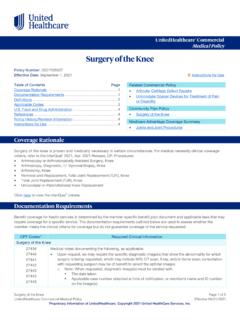Transcription of Knee Joint Replacement Surgery Post-Operative Exercise …
1 knee Joint Replacement Surgery C E N T E R. Post-Operative Exercise Program David F. Scott, MD. Weeks 1 through 6. 785 E. Holland Spokane, WA 99218 The goal of knee Replacement Surgery is to return you to normal functional activities as soon as (877) 464-1829 possible. Immediately after Surgery , the focus of your Exercise program should be on improving (509) 466-6393 quadriceps muscle strength, control of knee swelling, safe ambulation, and active/passive stretching Fax (509) 466-3072 to restore normal knee range of motion. Getting out of bed and taking the first few steps after knee Joint Replacement Surgery are challenging, but do get easier with time. Patients with knee Joint Replacement are urged to Exercise the knee frequently throughout the day to restore normal Joint range of motion.
2 The first 3 weeks after Surgery are the most important to prevent the development of scar tissue within the knee Joint . Active and passive stretching are the best ways to avoid long- term complications with your Joint Replacement . With that said, however, if you've had years of degenerative arthritis in the knee Joint with progressive weakness and difficulty with normal functional activities prior to Surgery , a period of outpatient physical therapy may be indicated to help best restore function in your new knee Joint . The most important activity in your recovery process is walking! In most cases you will be able to put as much weight as you desire on the operative leg while walking. You will be instructed on any weight-bearing restrictions before leaving the hospital.
3 Most patients leave the hospital using a front-wheeled walker. You should continue to use your walker until your strength returns. Progression to a cane, held in the hand opposite to the replaced knee , is indicated once you feel strong enough to walk without the assistance of the walker. (See Walking Recommendations). In most cases, you should continue to use a walker or a cane for the first six weeks after Surgery . However, some patients may require longer use of an assistive device than others. Exercises should be performed every day. You should allow 15 minutes, two to three times a day, to begin with. Progress to 30 minutes, two to three times a day, by the end of six weeks. Exercising more than what is recommended is completely safe for your knee Replacement .
4 With knee Replacement Surgery , it is very important to NEVER position a pillow under your knees to rest or sleep. This position bends the knee into a comfortable position, but can quickly lead to the development of scar tissue around the new knee Joint which may be difficult to resolve. To avoid developing a bad Joint contracture, always rest the knee fully out straight (even if you have some tenderness in the back of the Joint or calf). A flexion contracture of the knee can restrict normal walking and prolong rehabilitation needs after total Joint Replacement Surgery . Occasionally, further medical treatment is warranted to fix a stiff knee Joint . The best treatment for Joint contractures is to prevent them from occurring by strictly following your Post-Operative Exercise program as outlined.
5 It is very common for your new knee to stiffen and cause pain if sustained in a straight or bent position. You should avoid sitting for longer than one-half hour before standing, stretching, and walking. Prolonged sitting flexes (bends) the knee and can lead to a Joint contracture making straightening difficult. Revised September 6, 2011 1. knee Joint Replacement / post -op Exercise knee Joint Replacement Surgery Post-Operative Exercise Program David F. Scott, MD. Phase 1: Immediate Post-Operative Phase Day 1 through 2 weeks You should time the use of your narcotic medications to help control symptoms during your Exercise program as outlined here. Elevation and icing for 20 minutes after Exercise helps to control swelling and reduce pain as well.
6 Continue walking daily. Quadriceps Setting Exercise Lie on your back with the operative leg straight (no pillows or towels under your knee ). Tighten the quadriceps muscle on top of the thigh by pressing the knee straight down into your bed, holding for a count of 5 seconds. This Exercise can be repeated throughout the day. A towel roll under the heel helps to promote full straightening of the knee and is recommended. Repeat for 20-30 repetitions with 5 second holds. Complete 3 to 5 times per day for the first 2 weeks after Surgery OR, if able, complete as prescribed below. NOTE: You do not have to lie down in bed to do this Exercise . This Exercise can be done sitting in a chair and standing as well. We recommend completing 10 repetitions every hour during the day for the first 2 weeks after Surgery to help strengthen the quadriceps muscle and to promote full knee extension (straightening).
7 Straight Leg Raising Exercise Lie on your back with the operative leg straight (no pillows or towels under your knee ). Your non- operative knee should be bent to reduce pressure on your lowback. Perform a quadriceps setting Exercise to fully straighten the knee . Keep the leg completely straight and bend the hip so the operative leg raises from the bed to reach the level of the opposite knee . Complete 2-3 sets of 10 repetitions each, 3-5 times daily. Hold for 3-5. seconds then slowly lower. The leg should feel very heavy if this Exercise is done correctly. If you experience groin pain, stop and rest the leg before proceeding. If you are too weak to lift the leg by yourself, you should have a spouse or caregiver assist you with this Exercise .
8 Within 2 weeks after Surgery , however, you should not require any assistance in elevating your operative leg into/out of bed for transfers. C E N T E R. Revised September 6, 2011 2. knee Joint Replacement / post -op Exercise knee Joint Replacement Surgery Post-Operative Exercise Program David F. Scott, MD. Standing Hip Abduction Exercise Stand holding on to a solid object for balance and support. Raise the operative leg out to the side and slightly backwards. Hold for 3 seconds and slowly lower. NOTE: The movement should be to the side and BACK, not to the side and forward. It is normal for the toes to turn slightly outwards during this Exercise . Repeat 2-3 sets of 10-20 repetitions and then stand on your operative leg.
9 You should stand with your replaced knee Joint as straight as you can when bearing weight solely on your operative leg. Repeat 3 times daily. Advanced Exercise : Add ankle weights to operative leg (2-5 lbs recommended - begin with light weight). Sidelying Hip Adduction Exercise Lie on your knee Replacement side with the opposite foot placed on the bed either in front (or behind) your operative leg (your operative leg should be on the bottom; see picture). Tighten the muscles on your inner thigh and lift your operative leg off the bed towards the ceiling as high as you can. Hold the position at the top of the Exercise for 5. seconds. Relax and slowly lower. Some patients with diagnosed hip/ knee arthritis or previous Joint replacements in the non- operative extremity, may be unable to complete this Exercise .
10 Repeat 2-3 sets of 10-20 repetitions. Repeat 3 times daily. If you have a pre-existing hip Joint Replacement on the same side as your knee Replacement , you should receive medical clearance before beginning this Exercise . C E N T E R. Revised September 6, 2011 3. knee Joint Replacement / post -op Exercise knee Joint Replacement Surgery Post-Operative Exercise Program David F. Scott, MD. Ankle Pumps: Lie on your back in bed or on the sofa and elevate the operative leg. Pump the ankle Joint repeatedly, as shown, or trace the alphabet from letters A to Z. with your foot and ankle. Repeat for 3 to 4 minutes, 3 to 5 times per day. Long-Arc knee Extension Exercise : Sit on the edge of your bed. With the knee bent at a right angle off the edge of the bed, straighten the operative knee as fully as you can and hold for 5 seconds.
